What paint to paint heating radiators: a comparative overview of the types of paint for batteries + the best manufacturers
Thanks to coloring, heating batteries become more presentable and receive additional protection against corrosion. But the paint for heating radiators must be chosen correctly so that the updated coating lasts as long as possible.
We will help you in this matter. The article lists the requirements for enamels, describes the advantages and disadvantages of various paints. It also provides an overview of companies whose paints have proven wear resistance in practice.
The content of the article:
Can batteries be painted
With painting old solid cast iron batteries no problems should arise. It is only necessary to choose the right paint for them. But with aluminum or stainless steel radiators, the situation is radically different.
Initially, they are painted in the factory using a powder method with heat treatment. On top of this paintwork, applying a new coat of paintwork at home with your own hands is problematic.
The vast majority of manufacturers of non-cast iron heating appliances consider the unauthorized painting of the surface of the battery as a reason for voiding the factory warranty.
Any damage or peeling of the paint layer on a radiator just bought is a manufacturing defect. Such equipment must be replaced. Nobody has canceled the warranty period of service.
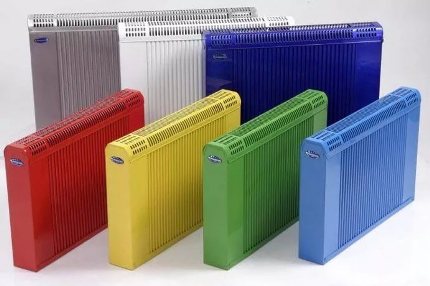
After drying, enamel paints create a strong and monolithic layer on the surface, the air through which is not able to pass by definition.
If oxygen leaves at least a small chance of seeping through the paint, then you can immediately forget about protecting the metal from corrosion. And protective functions are often the main reason for painting radiators.
At the same time, there is a categorical prohibition on filling the air outlet of the automatic air vent in the passports for all heating radiators. If you apply paint to it, then it will be impossible to bleed air from the heating system if necessary. This moment must be monitored during painting work.
The coloring of both aluminum and stainless steel at the plants is carried out by powder coloring compounds, which, after application, are “baked” in special boxes with a high temperature. It is impossible to create the necessary conditions at home.
And ordinary oil and other paints do not stay on such radiators for a long time. Due to their low adhesion, they will inevitably peel off from aluminum and steel surfaces.
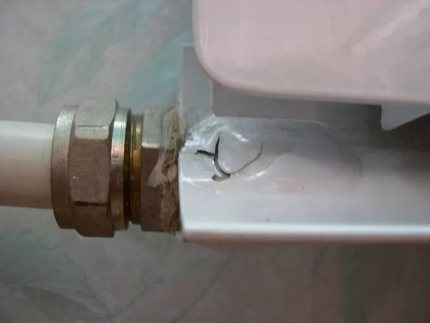
Reliable staining of aluminum requires special equipment for painting, as well as epoxy primers and enamels. All this costs a lot of money.
In addition, the slightest non-compliance with the technology inevitably leads to peeling of the applied coating. There is another option with anodic oxidation, but this is again technologically difficult and requires some knowledge.
If there is a successful experience in painting the car body and the corresponding paintwork materials, then for painting aluminum battery you can take it, otherwise you should not do it. It is better to purchase a new heating device or just close the peeling off decorative screen.
A separate topic is convectors with a private ribbed steel plate finning on a pair of pipes (“comb”). Such batteries were often installed in the 1970–80s in panel high-rise buildings. It is impossible to paint the plate ribs themselves. This will lead to a sharp decrease in heat transfer.
At the same time, getting to the pipes in the middle also fails even with a very narrow brush. These surfaces are best left alone.
These radiators usually have flaps and decorative screens from iron. Here they can and should be painted to give them an aesthetic appearance. Conventional heat-resistant paints are suitable here.
Enamel Requirements
The main thing in choosing a paint for a home heating radiator is its heat resistance. If the marking of the jar indicates that the composition has an operating temperature below + 80 ° C, then you should not take such paintwork for painting the battery.
Conventional paints and varnishes were not originally intended for painting heated elements of the heating system. After turning on the heating, they will begin to exfoliate or turn yellow.
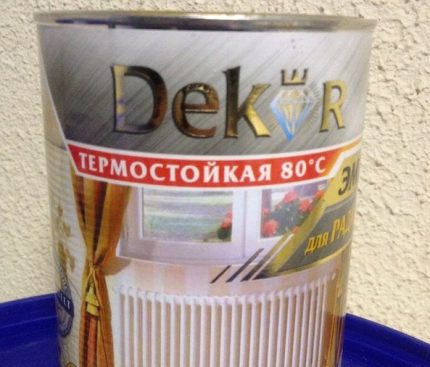
The paint for self-coloring of the heater must be at the same time:
- heat-resistant - at least + 80 ° C, and preferably + 100 ° C;
- moisture resistant and abrasion resistant;
- non toxic
- with high thermal conductivity;
- quick drying.
Some inexperience for batteries choose the usual non-heat-resistant paint for interiors. As a result, when heat is applied, it turns yellow or changes its original shade.
This is due to the presence in its composition of chalk or polymers that are not designed for high temperatures. Therefore, both the binder material and the pigment must be heat resistant.
The paint on the battery is usually applied in two layers. The faster each of them dries, the faster the radiator will be ready for use. Moreover, often the faster the paintwork dries, the sharper the smell the composition differs.
To prevent the family from having to inhale these amber, the heater is often easier to remove from the pipes and paint somewhere in the garage or on the street.
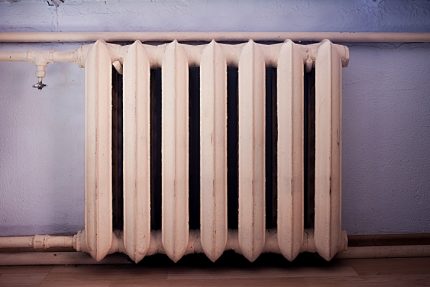
Choosing between a glossy and matte version, it should be remembered that the slightest irregularities are noticeable on a shiny surface. For rough and lumpy cast-iron batteries, it is better to choose a paint with a dull shade that will not give glare from the lighting.
On radiator cast iron there are often metal streaks and crevices. When using glossy enamel, all of them will certainly be in sight.
At the same time, it’s not worth it too much to align the cast iron surface of the battery with sandpaper before painting. This can lead to thinning of the radiator fins and the appearance of subsequently fistula.
Choice of paintwork materials for a heating radiator
With the selection options everything seems to be clear. Now it remains to understand what kind of paint is better to paint heating batteries in an apartment or private house.
There are many varieties of paintwork materials. Plus, the market has a huge number of manufacturers of various enamels. It is often difficult to choose the right paint material.
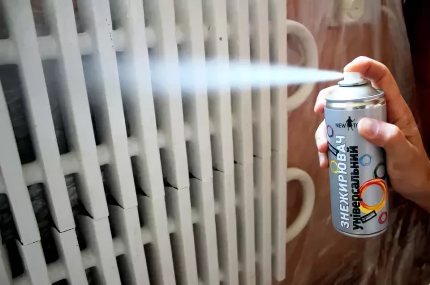
Heat-resistant paints for cast iron heating radiators are:
- oil based vegetable oils and drying oil;
- water emulsion (acrylic);
- alkyd.
Plus there is a "silver" and hammer paint. Each of these options has its own set of advantages. You should choose carefully.
Option # 1: oil
Previously, oil paints for coloring batteries were used everywhere. They are usually made on the basis of organic varnish and do not bite at a price. After their application and drying on the radiator, a coating sufficiently resistant to elevated temperatures, mechanical stress and moisture is formed.
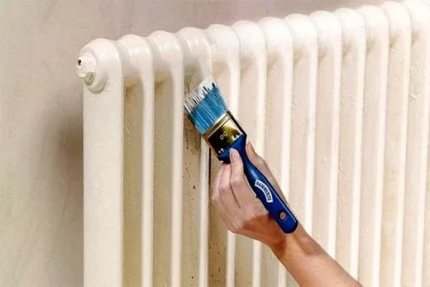
Among the negative aspects of the use of oil (varnish) paints are:
- Bad smell - sharp “aroma” when painting and drying.
- Durability of coverage - The battery will have to be repainted every two to three years.
- Large thickness of paint coat - as a result, a decrease in heat transfer of the radiator.
- Drying time - depending on the temperature in the room, the drying period may take up to 2 days.
- The likelihood of sagging, especially if the application technology is not followed.
If oil paint is not conventional, but heat-resistant, then it is unlikely to survive even one heating season. The coating of it on the battery when the temperature rises will immediately begin to crack.
Drying coatings based on varnish are best used only as a last resort, when there is simply nothing else on sale, or when the heating battery needs to be cheaply painted for only one season.
Option # 2: water-dispersed (water emulsion)
These paints are based on PVA or polyacrylates. The first to take for painting radiators is not worth it. They have low resistance to moisture. They are intended exclusively for interior painting of walls and ceilings.
On the metal, which may have to put wet mittens for drying, such coatings are not categorically suitable. They will immediately be erased from the surface of the heater.
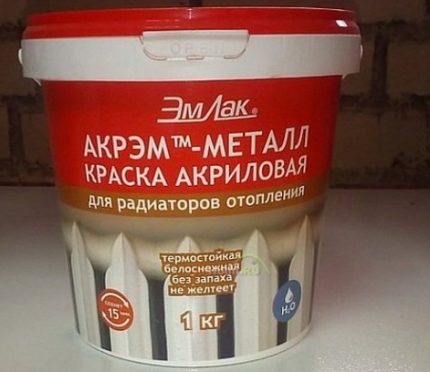
Heat-resistant acrylic enamels for radiators have the following advantages:
- dry quickly;
- form a durable coating;
- do not have a pungent odor;
- resistant to abrasion.
Most water-based paints on sale are white.To give them the right shade, you need to add the appropriate color to the composition. The coating formed with their help resembles plastic with a slight sheen. It is easy to clean and does not crack.
Option # 3: Alkyd
Alkyd resin based paints surpass the first two options in terms of heat resistance and resistance to water and detergents. This is the most practical and optimal choice for battery painting.
But most of these enamels presented in stores are not suitable for radiators. Choose a heat-resistant composition here as carefully as possible.
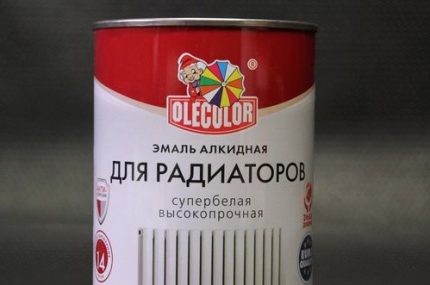
Depending on the composition of solvents and modifying additives, this enamel is divided into many varieties. Of all, it is worth highlighting the organic and organosilicon species. The first paint has a pungent odor, and the second - high temperature resistance.
Organo-silicon alkyd paint based on polyorganosiloxane polymers is used to paint not only batteries, but also furnaces, chimneys, boilers and fireplaces. It does not contain salts, which upon heating begin to crystallize, thereby reducing the strength of the paint layer.
This enamel calmly tolerates temperatures up to + 600 ° C. However, when using it, care must be taken to ensure high-quality ventilation of the room. When dried, it emits toxic fumes, so it is best to paint work on the street.
Option # 4: Silver
If white is optional, you can also use the good old silver. This is aluminum powder mixed with solvent and bitumen varnish. At the same time, you should not take ready-made paints (for example, BT-177), which do not differ in temperature resistance by definition.
It is best to prepare silverfish yourself from PAP-1 powder and BT-577 varnish. When mixing them in the right proportions, you can get a paint designed for temperatures of 300-400 ° C.
It is only necessary to observe the ratio of components prescribed in the instructions for the preparation of this composition. Such a coating on a heating battery will last more than one year.
Manufacturers at a Glance
On sale are heat-resistant paints and varnishes for painting heating systems, both imported and domestic. Both of them are quite suitable for coloring the battery in a cottage or apartment.
Among the main manufacturing companies can be mentioned:
- Scandinavian TIKKURILA with the Termal series.
- German DUFA Thermo and Aqua-Heizkorperlack series.
- Russian Tex with special “enamel for radiators”.
- Polish SNIEZKA.
- Slovenian Belinka.
- Russian LACRA.
There are many options with different prices and composition, there is plenty to choose from. Moreover, when choosing a primer for paint, it is best to opt for products from one manufacturer. Experimenting with mixing what’s cheaper isn’t worth it.
An overview of popular thermal paints that are used for coloring radiators, metal furnaces and other elements of the heating circuit is given in this article.
Conclusions and useful video on the topic
Choosing an enamel for painting a cast-iron radiator is easy, you just need to carefully look at the label. And the selection of video materials below will certainly help you navigate the existing varieties of heat-resistant radiator paints.
Rules for choosing enamel for heating batteries:
How to paint a cast iron radiator:
What enamel should the batteries be painted with:
The first paint that catches your eye is not worth painting the heating radiator. For these purposes, special heat-resistant enamels should be chosen.
If you take the usual paintwork material, then the coating from it when the battery is heated will quickly become worthless.Also, when choosing, you need to look so that among the components there is no chalk, yellowing when heated.
Looking for quality paint for heating radiators? Or have experience using heat-resistant enamels? Please leave comments on the article, ask questions and participate in the discussion of the material.

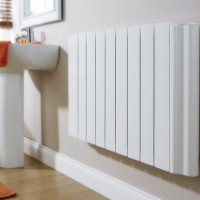 Vacuum heating radiators: overview of types, selection rules + installation technology
Vacuum heating radiators: overview of types, selection rules + installation technology 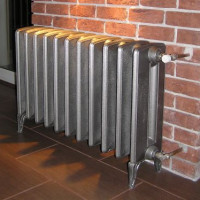 Cast-iron radiators: characteristics of batteries, their advantages and disadvantages
Cast-iron radiators: characteristics of batteries, their advantages and disadvantages 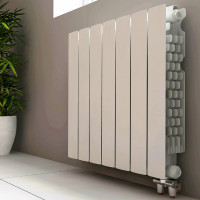 Steel heating radiators: varieties, characteristics and advantages of batteries
Steel heating radiators: varieties, characteristics and advantages of batteries 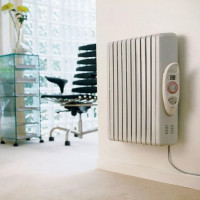 Electric heating radiators: the main types, advantages and disadvantages of batteries
Electric heating radiators: the main types, advantages and disadvantages of batteries 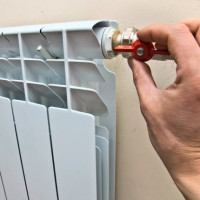 Aluminum heating radiators: overview of technical characteristics + installation principles
Aluminum heating radiators: overview of technical characteristics + installation principles  How much does it cost to connect gas to a private house: the price of organizing gas supply
How much does it cost to connect gas to a private house: the price of organizing gas supply  The best washing machines with dryer: model rating and customer tips
The best washing machines with dryer: model rating and customer tips  What is the color temperature of light and the nuances of choosing the temperature of the lamps to suit your needs
What is the color temperature of light and the nuances of choosing the temperature of the lamps to suit your needs  Replacement of a geyser in an apartment: replacement paperwork + basic norms and requirements
Replacement of a geyser in an apartment: replacement paperwork + basic norms and requirements
If you go from far away - I do not understand the meaning of painting aluminum and steel radiators. But in essence, if - then aluminum and steel radiators, I myself would not recommend painting. This threatens a number of problems, including for health and safety. I think that you can paint only cast-iron batteries, and the paint should be appropriate, not just any of the hypermarket. We personally use two brands, I will not advertise, but they are in the body of the text.
Tired of the white color of the cast-iron battery in the living room, we decided to update it and paint it in the main tone of the room. For this, “metallic gold” spray paint was used. She also painted part of the wall where the radiator is installed. It turned out very cool, stylish, minus consisted of a persistent smell that weathered for several days. But the result was worth it.
In the old apartment, old cast-iron batteries were painted with ordinary white paint, then there was a constant unpleasant smell. But after a few months, the coating we applied turned yellow and began to crack. Somehow they tried to paint the batteries with automotive spray paint. She lasted much longer, and did not even change color. But in the end, they put aluminum and now there are no thoughts on how to restore the outer layer.
In your picture, where the radiator seems to be painted from a spray can, it says “znizierhiruvach universalny” on the spray can’t, which means “universal degreaser” in translation ...
Well, that's right - degrease first, then paint = D
I would like to add that usually experts do not recommend painting radiators in the first year of operation, since paint can hide the factory defect of the radiator casing, which is invisible during the experimental start-up, and worsen the situation.